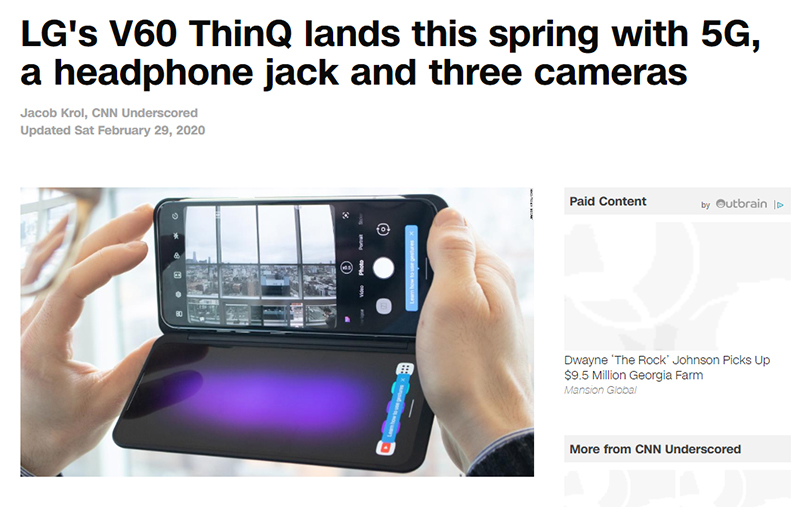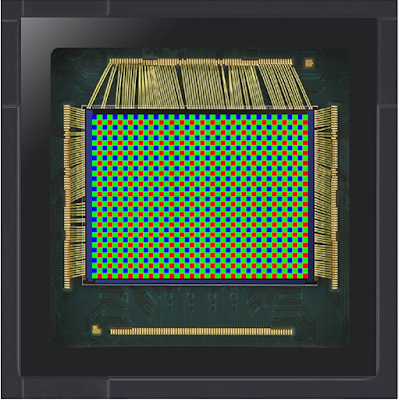LG V60 ThinQ targets North America and Europe
LG Electronics' premium smartphone LG V60 ThinQ 5G revealed its appearance. LG Electronics originally planned to release the LG V60 ThinQ 5G at MWC (Mobile World Congress) 2020. However, as the new Coronavirus (Corona 19) canceled MWC itself, LG Electronics released the product through the LG Global Newsroom.

The reason why the LG V60 ThinQ 5G is a hot topic is that it will change LG Electronics' sales strategy. Earlier on January 30, the earnings announcement (conference call) said, "The V60 will be prepared as a North American, European and global exclusive product, and the Korean premium market will have a mass premium phone with design and reasonable price." This is the first result of the strategy. In other words, the LG V60 ThinQ 5G will not be sold in Korea, but only in North American, European and Asian markets.
Domestic non-launch is talking about, V60 what phone?

The LG V60 ThinQ 5G is a premium 5G smartphone with a Qualcomm Snapdragon 865 AP, 8GB of RAM, and a Qualcomm X55 5G modem. Unlike the domestic market, which has reached saturation, the overseas market is attracting attention because 5G smartphones are just being introduced and there are few options for 5G smartphones. The display features a 6.8-inch P-OLED full-vision display with a 20.5: 9 ratio and supports FHD + (2,460x1,080, 395ppi) resolution.

Storage consists of 128GB and 256GB, with a micro SD slot that can expand up to 2TB. As the competition for smartphone cameras has heated up recently, the LG V60 ThinQ 5G also has a 64 million pixel standard lens and 13 million pixels wide-angle lens. The camera supports 8K video recording, and four microphones make recording sound clear. The battery is also generously available at 5,000mAh.

Dual screens, a key feature of LG's premium smartphones, also have significant performance. Considering the environment with the main screen, the same 20.5: 9 6.8-inch P-OLED full-vision display is mounted, and the resolution is the same as FHD + (2,460x1,080, 395ppi). It weighs 134g and connects with a 360-degree hinge and a USB C standard.

The US CNN cited audio jacks and cameras as advantages.US CNN wrote a review article titled "LG's V60 ThinQ and 5G landed this spring: a headphone jack and three cameras." The article starts with the announcement of Samsung's 5G smartphone, but now it's LG's turn. Unlike Samsung Electronics, LG Electronics puts its launch models together and emphasizes dual-screen and 5G support.

The authors note that they do not fold like the Galaxy Fold, Motorola Razr, or Galaxy Z Flip, but the screens are separated by dual screens and that they can be used as controllers to run multiple tasks simultaneously or while gaming. The 3.5mm headphone jack is also a big advantage. Overall, the LG V60 ThinQ 5G is a unique smartphone and stated that the conditions for providing dual screens at no additional cost are satisfactory.

TechRadar. Indicated that LG Electronics is looking for its direction. In particular, it was noted that the screen divided into dual screens would be a powerful multimedia device combined with a high-speed 5G network. Instead of an expensive foldable display, it only has a simple extra screen. Its advantages include dual screens, a large capacity battery, and 8K video recording, and the shortcomings include lack of resolution, telephoto lens removal, and dual-screen support for more apps.

9to5Google noted that in 2020, most smartphone manufacturers unplugged the headphone jack and that the LG V60 ThinQ 5G is the only flagship smartphone with an audio jack. LG has consistently satisfied audiophiles with headphone jacks and high-performance DACs. It also supports the Snapdragon 865 and 5G, with a price tag of around $ 1,000.
Dual screen and audio jacks are the keys

According to market research firm Counterpoint Research, 74% of 5G smartphones sold in the U.S. in 2019 were from Samsung Electronics. LG Electronics held a 15% share, while China OnePlus took 11% of the market at an affordable price. Three out of four 5G smartphone users use Samsung Electronics, while the other one uses LG Electronics or OnePlus.
This result implies that it is important to have unique colors of LG Electronics. While endurance issues continue to be pointed out inexpensive foldable smartphones, it should be emphasized that an affordable, stable, dual-screen alternative is an alternative. Besides, while other brands are giving up audio jacks, they need to meet the demand of those looking for audio jacks to utilize expensive audio equipment.
In the U.S., 2019, 5G smartphone penetration was only 1% of total smartphone sales. This year, about 25% of all smartphones will be distributed to 5G smartphones. It is noteworthy whether LG Electronics will succeed in the global market with a dual-screen and audio terminal.







![[Review] Fit for esports gamers, Asus VG248QG data:post.title](https://blogger.googleusercontent.com/img/b/R29vZ2xl/AVvXsEjhHpZcqqsaTPaQvOuy7661F2plo_Av6gvMB9AqZMs9efVHVI6fYvsHcrqPFsyFdw_HuNzLBPM0OVIVUpsO1KxsHcL49mjbE_qzburcoVKllogfO6y62r_c_i-KLJms9_W9ZJy_ZpVm_D3o/s72-c/Asus+VG248QG%252C+0.5ms+response+time+at+165Hz+is+key.5ms+response+time+at+165Hz+is+key.jpg)
![[Review] Canon EOS-1D X Mark III, 2020 Edition 'End King' DSLR Camera data:post.title](https://blogger.googleusercontent.com/img/b/R29vZ2xl/AVvXsEjzeCR_-TPKj7GzvXQIGc1lM5Hj_J0ZiSWox4AAthLeL1iAPbFbQb4tzpgWHlb51V4PPQoRMiJ_2GECa51S_uGmEgC4KjqMKdBHrgAhyphenhyphenW2aK5DQE5FNLOAaRB7WyHNz_v_KfcguFD9PSmCA/s72-c/0.jpg)